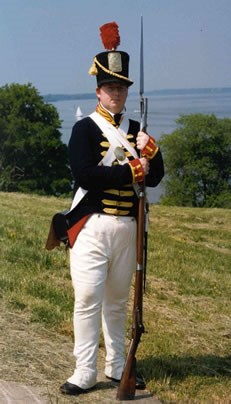
First Forts The smoke had scarcely cleared from the battlefields of the American Revolution when the new country found its maritime commerce threatened by France, its once friendly ally. The French experienced their own revolution and the new government encouraged their navy to help support the war by capturing commercial vessels in the West Indies. On March 20, 1794 the U.S. Congress responded to the threat by appropriating funds to organize a navy department and construct defensive forts at the most important seaports. The newly authorized navy sailed to the Mediterranean and after taking 85 French vessels, the Quasi War with France ended. From 1801 to 1805 the navy was engaged in the war with Tripoli but there was no threat to our shores. The forts were abandoned and allowed to fall into disrepair. Second Fort System At the end of the French Revolution, Napoleon Bonaparte became Emperor of France and a series of European conflicts known as the Napoleonic Wars began. The United States tried to resist being drawn into the fray by declaring neutrality but demanded free trade with all Europe. Britain and France declared a naval blockade of each other's ports and both countries preyed on the American merchant fleet. When the conflicts moved into the Caribbean, the United States Congress thought the war dangerously close and authorized a second fortification system. Almost every important seaport received a few batteries but like the first system most of these forts were built of earth and wood. Congress never intended the forts to be the only defense. They also provided funds for a large militia force to augment the small regular army and support the defensive forts. Fort Warburton was one of the forts built under the second fortification system. 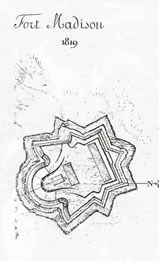
Fort Warburton When the first fort system was authorized in 1794, General George Washington wrote Secretary of War Henry Knox "The president of the United States, who is well acquainted with the River Potomac, conceived that a certain bluff of land on the Maryland side near Mr. Digges; a point formed by an eastern branch of the Potomac, would be a proper situation for a fortification to be erected." The $3,000 authorized for the project was spent trying to build a fort at Jones Point, on the Virginia side of the river. In 1798 Washington again urged that a fort be built at Digges Point but no work was done. Finally, in 1805 when Congress was contemplating a second fortification system the Secretary of War directed Lieutenant Colonel Jonathan Williams to evaluate Digges Point for a "circular battery, say of twelve cannon." 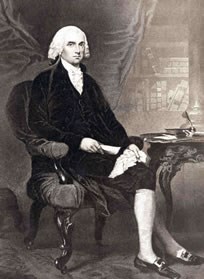
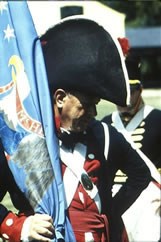
War of 1812 While France and Britain were at war the British navy impressed over 6,200 American sailors and one of their warships fired on the USS Chesapeake killing and wounding several sailors. On June 19, 1812 war was declared to defend the principle of "free trade and sailor's rights." The U.S. Navy of 14 seaworthy ships took to the seas against 1,048 British war vessels. They soon demonstrated the excellent American ship design, seamanship, and gunnery but they could not overcome the dominating number of British warships. By 1813 most U.S. ships were forced into port to elude the Royal Navy while the British played havoc along America's Atlantic and Chesapeake shore. 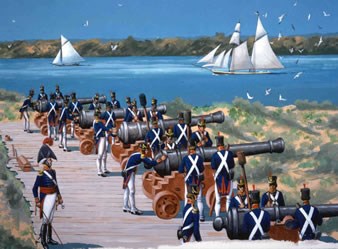
A British squadron made an attempt to ascend the Potomac in July 1813 but turned back after meeting some resistance from militia and encountering the treacherous Kettle Bottom Shoals. In Washington, concern for the safety of the Capital caused the President and Secretary of the Navy to visit Fort Warburton. Afterward Major Pierre L'Enfant was sent to evaluate the fort and reported "the whole original design was bad and it is impossible to make a perfect work of it by any alterations." The Secretary of the Navy ordered and additional water battery of 9 guns to be built and manned by seamen under Lieutenant Decius Wadsworth. The name Fort Washington was gaining popularity but official correspondence often indicated Warburton, Digges Point, the Fort at Warburton, Fort Warburton and Fort Washington above the date line. In April, while Sir John Cockburn's squadron was busy harassing the Atlantic and Chesapeake cities, Paris fell to the allied forces. The war with France was over so additional British troops were free to pursue the war in America. General Robert Ross, a veteran of the Peninsula War, was sent to America with orders to "effect a diversion on the coast of the United States of America in favor of the army employed in the defense of Upper and Lower Canada." In early August part of the naval squadron entered the Patuxent River and sailed to Benedict, Maryland. The army landed and began to march northward. The remainder of the squadron under Captain James A. Gordon began ascending the Potomac River. The Secretary of War, General Armstrong did not see any military value to Washington. He believed that the British movement toward the Capital was a ruse and insisted that their destination was Baltimore so no effort was made to strengthen the Washington defenses.
When the British Army reached Long Old Fields, now called Forestville, General Armstrong finally took measures to protect the Capital. On August 22, 1814 Brigadier General Robert Young was ordered to move his 600 militia to the Washington-Piscataway road to defend the approach to the fort now being called Fort Washington. General William Winder sent orders to Captain Samuel Dyson, "to advance a guard up to the main road upon all the roads leading to the fort, and in the event of his being taken in the rear of the fort by the enemy, to blow up the fort and retire across the river." Thomas Tingey, Commander of the Navy Yard proposed placing Marines at Fort Washington but was refused by General Winder who did not consider Fort Washington tenable. On the morning of August 24th and advanced party of 1,500 British soldiers met the American militia at Bladensburg. The British army entered and burned Washington after the American defense force of 6,500 militia retreated. The British then marched back to Benedict, Maryland.

Warburton Destroyed While the British Army was burning Washington there were only 56 men at Fort Warburton. The fort had 26 guns ranging from 50-pounder Columbiads to 6-pounder field pieces and over 3,000 pounds of cannon powder. Nine guns were capable of firing down river (many of the other cannons lacked implements). On the 27th the British fleet of 10 ships approached the fort. Captain Gordon's report states that "A little before sunset the squadron anchored just out of gunshot; the bomb vessels at once took up their position to cover the frigates in the projected attack at daylight next morning and began throwing shells until about 7:00pm. The garrison, to our great surprise, retreated from the fort; and a short time afterward Fort Washington was blown up." The next morning the fleet paused in front of the fort completed the destruction, then sailed to Alexandria. On August 29th the city capitulated. The British seized 21 merchant vessels and confiscated the tobacco, cotton and other produce on the docks. The Americans hastily constructed a couple of batteries on the Potomac to harass the fleet on their way down river. The Battery at White House Landing under the command of Capt. David Porter fired upon the British Fleet from September 3rd to 5th(the Battle of White House Landing was inconclusive). Once the British salied down river Major Pierre L'Enfant was sent to Digges Point to construct new defenses in case the British decided to return. Captain Dyson was relieved of his command and ordered to his home in Alexandria. A court martial found him guilty of abandoning his post and destroying government property. He was dismissed from the service. The Secretary of War General Armstrong was forced to retire and abandon his ambition to become President because of his failure to protect the Capital. After the War of 1812 the government began preparing for a new fortification system to resist the next American-European war. There was wide spread belief that Britain would never allow America to rise to national greatness or become an independent economic power. In 1816 a fortification board began to plan a new defense system. These forts were to be permanent and large enough to defend their position as well as the pass they guarded. On March 3, 1821 Congress appropriated funds to begin the new permanent seacoast fortification system. Although a new Fort Washington was started under the second fortification system it had many of the features of the third system. In the 1840s engineers were sent to the site to strengthen the walls and bring the fort up to the standards of the third system. The new Fort Washington was never challenged but served as the Capital Guardian until it was replaced with modern gun batteries. 
|
Last updated: April 10, 2015
